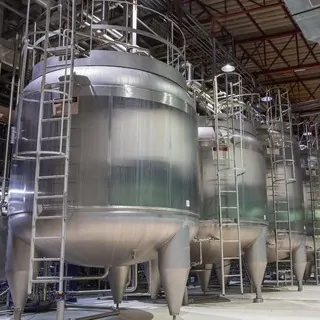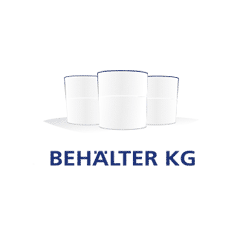
Sterile tanks for aseptic storage: properties and special features
The aseptic storage of liquids plays a crucial role in many industries, especially in the food, beverage and pharmaceutical industries. Sterile tanks are used for this purpose, in which sensitive products, such as milk, can be stored before aseptic filling. In this article, we would like to summarise the most important features of a sterile tank and show why these tanks are indispensable for aseptic storage.
What is a sterile tank?
A sterile tank, often referred to as an aseptic tank, is a specially developed tank for the sterile storage of liquids that are particularly sensitive to contamination. The purpose of a sterile tank is to protect the product from microbial contamination while maintaining the quality of the product over a longer period of time. Sterile tanks are primarily used in production processes where the highest hygiene and safety standards are required. Usually, sterile tanks are operated with overpressure, whereby the product chamber is pressurised with sterile air or inert gas.
Special features of a sterile tank
Sterile tanks stand out from conventional tanks due to several special features:
- Sterile atmosphere control:To ensure aseptic storage, a controlled sterile atmosphere is often maintained in the sterile tank. This is achieved by introducing sterile gases (e.g. nitrogen), which prevent the penetration of oxygen and thus the proliferation of microorganisms.
- Hermetic sealing:One of the most important properties of a sterile tank is its hermetic seal. This means that neither air nor other particles can penetrate the tank from outside by pressurising the product chamber. This minimises the risk of contamination by bacteria, germs or other microorganisms.
- Materials and surface finishes:Sterile tanks are usually made from stainless steel, often from particularly corrosion-resistant alloys such as 1.4404 or 1.4571 (‘V4A’). The weld seams in the product area are ground to create the smoothest possible surface. The roughness of the surfaces in contact with the product is Ra ≤ 0.8 µm, although in the pharmaceutical sector there are sometimes even higher requirements (e.g. electropolished surfaces). The resulting hygienic design ensures that as few bacteria or product residues as possible can accumulate in the interior.
- Integrated sterilisation systems:Another advantage of sterile tanks is the possibility of CIP (Cleaning-in-Place) and SIP (Sterilisation-in-Place) cleaning. These systems make it possible to clean and sterilise the tank after each use without having to open it. Sterilisation and cleaning are usually fully automatic, which makes the production process more efficient and safer. Sterilisation of the product interior with steam, e.g. at 120°C, makes it essential that the sterile container is also designed for a slight negative pressure or vacuum.
- Operating pressure and operating temperature:Sterile tanks are designed to fulfil specific pressure and temperature requirements. Typically, a sterile tank is designed for an operating overpressure of +3.0 bar and full vacuum (-1.0 bar operating vacuum). The operating temperature of a sterile tank ranges from below 0°C to 150°C to allow aseptic storage and regular steam sterilisation to be carried out safely. An external cooling jacket ensures efficient cooling of the product chamber through the circulation of cooled water in the cooling coil of the double jacket.
- Sterile valves and fittings:In order to fill the contents of the tank aseptically, sterile tanks have special sterile valves and fittings that ensure the hygienic transfer of liquids. These connections are designed to prevent cross-contamination by particles or microorganisms from outside.
Advantages of aseptic storage in sterile tanks
- Maintaining product quality:Sterile tanks protect sensitive liquids from contamination and help to maintain quality over a longer period of time.
- Extended shelf life:Sterile storage means that the product has a longer shelf life, which is crucial for the storage and transport of perishable goods.
- Safe process:The automated cleaning systems and sterile connections minimise the risk of human error and therefore the risk of contamination.
Applications of sterile tanks
Sterile tanks are used in various industries, especially where hygiene and product safety have the highest priority:
- Food and beverage industry:Sterile tanks are used particularly in the production of dairy products, fruit juices and baby food.
- pharmaceutical industry:Sterile storage is crucial in the production of vaccines, medicines and other biotechnological products.
- Cosmetics industry:For special lotions, serums or sterile solutions, sterile tanks play an important role in preventing contamination.
Are sterile tanks also available to buy second-hand?
Behälter KG constantly stocks a wide range of used sterile tanks, from small 500 litre sterile tanks to sterile tanks with a capacity of up to 40,000 litres. Used sterile tanks often come from well-known large dairies or food companies, where they are taken out of service due to production relocations or closures. Used sterile tanks and aseptic containers are available immediately and do not require a long delivery time. They are also significantly cheaper than a comparable new purchase, which minimises the investment risks. Many used sterile tanks are equipped with high-quality sterile fittings, magnetic stirrers and other practical features. The history of use can be traced thanks to the documentation that is usually available. On request, we can also offer a crack test of the product interior for all our used sterile tanks. Before you decide to purchase a used sterile tank, you can see the quality of our products for yourself at our central warehouse in Bremen.

(Example image of a used sterile tank)
Conclusion
Sterile tanks are indispensable in the production and filling of various foods, beverages and pharmaceuticals. By pressurising the product area with sterile gases, storing under constant overpressure and using sophisticated cleaning and sterilisation processes, products with the highest hygiene requirements can be processed safely and without contamination. As an alternative to factory-new sterile tanks, there is also the option of utilising a wide selection of used sterile tanks, which involve a comparably low investment and short delivery times.
